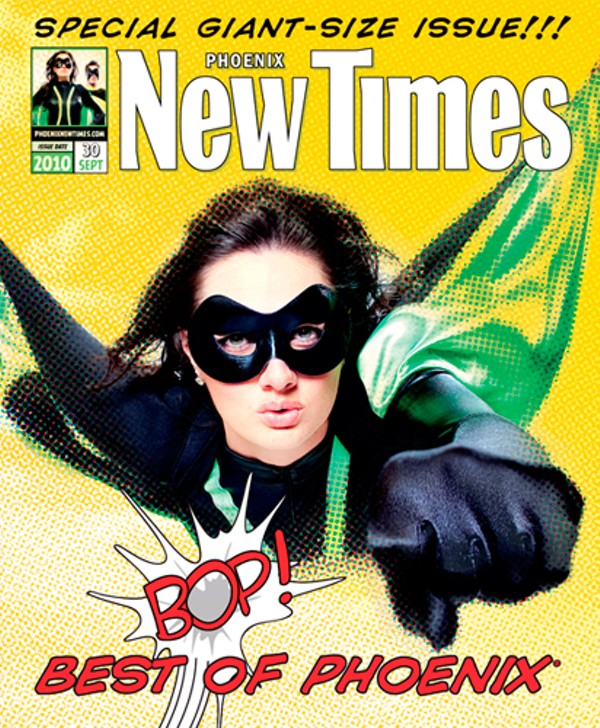Best Pompous Color Commentator
Phoenix Suns' Eddie Johnson
Best Championship Franchise
Phoenix Mercury
Best Failure
ASU Football's Dennis Erickson
Best Retirement
Former Cardinals QB Kurt Warner
Best Place to Improve Your Daredevil Skills
USA Martial Arts

- 4731 E. Greenway Rd., Phoenix, 85032 Map
- 602-896-8721
- www.usa-martialarts.com
Best Way to Get Your Wonder Woman On
Fighter Combat International

- 5865 S. Sossaman Rd., Mesa, 85212 Map
- 480-279-1881
- www.fightercombat.com
Best Place to Fly Like a Superhero
Trapeze U

- 14407 E. Pecos Rd., Gilbert, 85295 Map
- 888--101
- www.trapezeu.com
Hero Worship
Luis Gonzalez
See: a video interview with Luis Gonzalez.
Sports superstars in Phoenix have a nasty habit of choking in big-game opportunities. Not so with Luis Gonzalez.
With one extraordinarily timed swing of his baseball bat during the 2001 World Series, the Arizona Diamondbacks slugger reinforced his hero status to thousands of locals — myself included — by doing what Charles Barkley or Kurt Warner never could: He brought a major-league championship to the Valley.
And I got to witness this historic occasion firsthand after dropping $400 on eBay for a nosebleed seat inside what was then Bank One Ballpark.
Gonzo's triumph was one of the most thrilling moments of my life and the stuff of baseball lore: game seven, bottom of the ninth, bases loaded, score tied — against the dreaded New York Yankees. On the mound was the Bronx Bomber's notorious Mariano Rivera, one of the deadliest closers in baseball.
Few players have scored against Mighty Mariano, especially during a Fall Classic. But when Gonzo swung for the fences on that fateful evening, he transformed a cut fastball into a game-winning bloop single. It shattered his bat and obliterated decades of Phoenicians' frustration with athletic also-rans who just couldn't grab hold of the brass ring.
Gonzalez overcame such insurmountable odds for most of his career. Before donning a D-Backs uniform in 1999, he spent nearly a decade shuffling among three MLB teams (Detroit Tigers, Chicago Cubs, and Houston Astros) as an ignominious utility player.
After moving to Phoenix, however, he became a sports legend, home run machine, and the most beloved player in team history. Fans like me loved his countless crowd-pleasing swats as well as his affable nature, sense of humor, charity work, and family-man image.
Gonzalez has always been approachable. He never seems to refuse giving an autograph or handshake to fans, whether he's in public with his wife and triplets or by himself at a pro wrestling event (like me, he's a longtime follower of World Wrestling Entertainment).
Despite having ended his baseball career in 2009 with the Los Angeles Dodgers, he's still popular in the Valley. A sellout crowd (a rarity these days) packed Chase Field last month to watch Gonzo become the first Diamondbacks player to have his number retired. And many fans are hoping he can turn around the team's fortunes in his current front-office job as special assistant to team president Derrick Hall.
Ever the humble one, however, Gonzo tends to shirk his heroic status.
"I don't really consider myself any different than anybody else," he says. — Benjamin Leatherman
New Times clubs editor Benjamin Leatherman, who has suffered through decades of losing seasons by Valley sports teams, interviewed Luis Gonzalez on September 3 at Chase Field in Phoenix.
I live in Phoenix because I love the hot weather.
When I was a kid, I wanted to guide the airplanes in with the orange sticks, actually.
While I'm driving, I enjoy listening to the radio.
Phoenix could use more air-conditioning, more shade.
Phoenix could use less of those intersection radar light things.
Umpires are nice guys at times.
Right before I got the game-winning hit in the World Series, I thought, "Oh, my god, don't screw this up."
The one athlete (alive or dead) that I would have liked to meet would be Roberto Clemente.
The best thing about being a hero to people is when they finally get to meet you, they realize you're just a normal guy.
Right before I go to bed, I always put a bottle of water and a bottle of Gatorade by the bed.





